Inocybe erubescens A. Blytt - Deadly Fibrecap
Phylum: Basidiomycota - Class: Agaricomycetes - Order: Agaricales - Family: Inocybaceae
Distribution - Taxonomic History - Etymology - Identification - Toxicity - Reference Sources
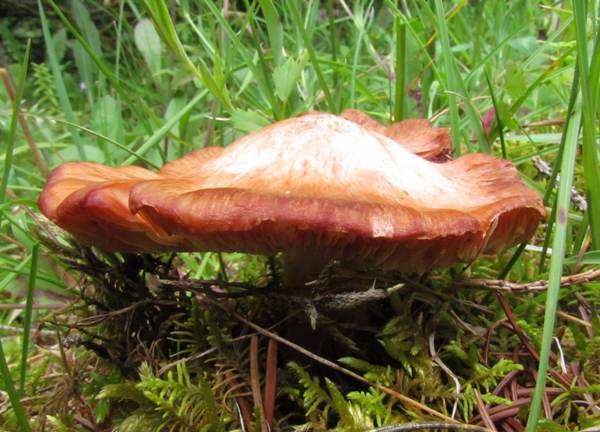
Inocybe erubescens occurs under broad-leaf trees, in summer and autumn. This fungus contains the dangerous poison muscarine, and so it must be avoided at all costs when gathering fungi to eat.
Inocybe is a difficult genus, with numerous species which, to the naked eye, appear to be virtually identical; the differentiating features can be seen examined with a microscope... but even then it is hard to separate some Inocybe species.
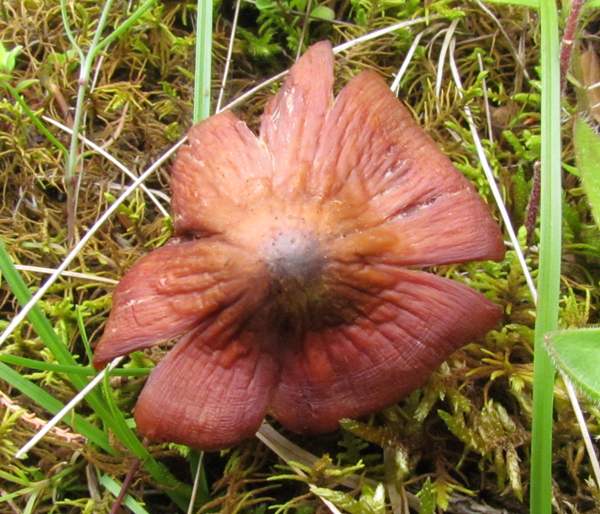
Alan Outen and Penny Cullington have produced a very detailed key, without which I would not want even to attempt identification of fibrecap mushrooms. It takes time: this is not a simple process, but it is very straightforward to follow. You need specimens in prime condition complete with any basal bulb, and it is crucial to minimise handling, otherwise this may remove caulocystidia (stem cystidia) or other identifying features. See the references section below.
Distribution
Inocybe erubescens is a rare find in Britain and Ireland, where it is mainly confined to the south. Having hunted for fungi in Wales for nearly 40 years and never yet found this species, I am far from surprised to learn that it has not yet (2014) been formally recorded in Wales; however, it is almost certainly present and the Forest of Dean seems to be an ideal location.
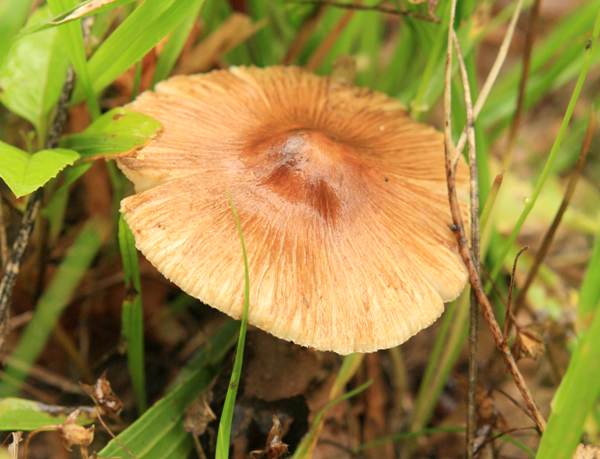
Most recorded finds of the Deadly Fibrecap are from southern England, and the New Forest, in Hampshire, is one of the hotspots, but that may simply be due to intensity of recording effort rather than favoured distribution.
These toxic toadstools are also found in many parts of central and southern mainland Europe, where Inocybe erubescens is generally less of a rarity. Most of the Deadly Fibrecaps shown on this page were found in the foothills of the Julian Alps in Slovenia in June 2014, but the lovely (to see but definitely not to eat!) specimen shown above was photographed in Bulgaria in 2009.
Taxonomic history
In a 1905 publication, Norwegian botanist Axel Gudbrand Blytt (1843 - 1898) described this toxic toadstool, giving it the scientific binomial name Inocybe erubescens, by which name it is generally referred to today.
Synonyms of Inocybe erubescens include Inocybe patouillardii Bres., and it was by this name that the Deadly Fibrecap was generally referred to in field guides until quite recently (although the English commonly name most often used by the non-scientific community at that time was the Red-staining Fibrecap).
Etymology
Inocybe, the genus name, means 'fibrous head', while the specific epithet erubescens means 'becoming red'. (The formerly popular common name 'Red-staining Inocybe' might suggest that handling these fungi might result in your fingers becoming red stained: not so!)
Toxicity
Inocybe erubescens grows in habitats where people expect to find edible mushrooms. This is a deadly poisonous toadstool and large enough for inexperienced foragers to consider these toadstools worth collecting for food. That makes it very dangerous indeed. Under no circumstances should Inocybe erubescens be included in collections of fungi intended for human consumption; it is every bit as deadly as its common name suggests.
While many of the fibrecaps - Inocybe fastigiata and Inocybe geophylla for example - are known to contain the toxin muscarine, according to toxicologist Kasturi Ravikant Bhambid Inocybe erubescens is the only one known conclusively to have caused deaths.
Identification guide
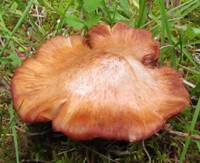 |
CapThe silky cap of Inocybe erubescens has a diameter of 3 to 7cm. Initially conical, it flattens as it matures, retaining a pointed umbo and streaky radial fibres that gradually redden from the inrolled margin. The cap surface bruises red. Especially in dry weather caps become marginally lobed and tend to split radially from the edge. |
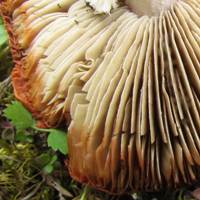 |
GillsCrowded and adnexed or adnate, the gills start off whitish and gradually turn pinkish-brown from the margin inwards. The gills redden also if they are bruised. Cheilocystidia(Cystidia on the edges of the gills): thin-walled, cylindrical or slightly clavate. |
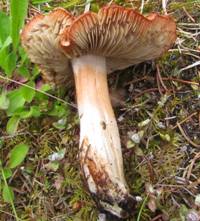 |
Stem8–10cm long and 1-2cm in diameter, the stem is white with longitudinal fibrils that stain red. The stem base is usually slightly swollen. When cut or broken, the whitish stem flesh does not change colour significantly. |
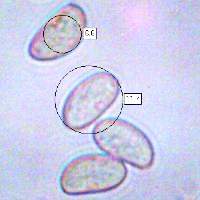 |
SporesBean-shaped, smooth 10-13 x 5.5-7µm.
Spore printDull brown. (Mouseover the spore image to see a larger version of this photomicrograph.) |
Odour/taste |
Little or no odour when young and fresh, but old fruitbodies smell unpleasant. Reported to have a mild taste, but this is a deadly poisonous fungus and it is dangerous to taste even a tiny bit. |
Habitat & Ecological role |
Mycorrhizal; occurring singly or in small groups beneath deciduous trees, most notably Beeches and Hornbeams nearly always on alkaline or at least neutral soil. I have only ever found these mycorrhizal fungi on woodland edges, but they are also recorded from within woodlands. |
Season |
Late June to September in Britain and Ireland. |
Similar species |
The white variety of Inocybe geophylla is smaller and does not redden. While the caps are immature, several other fibrecap species, including for example the Torn Fibrecap Inocybe rimosa, can look rather similar to Inocybe erubescens, so that the use of specialist keys, microscopic examination and sometimes chemical tests may be necessary to achieve confident identification to species level. |
Culinary Notes
This is a deadly poisonous toadstool and large enough for inexperienced foragers to consider these little toadstools worth collecting for food. Several Inocybe species are known to be deadly poisonous and difficult to identify with confidence, but Inocybe erubescens is one of the few that are known to have caused deaths, and so they should all be avoided when gathering fungi for food.
Reference Sources
Fascinated by Fungi, 2nd Edition, Pat O'Reilly 2016, reprinted by Coch-y-bonddu Books in 2022.
BMS List of English Names for Fungi
Alan Outen and Penny Cullington (2009), Keys to the British Species of Inocybe.
Kasturi Ravikant Bhambid, Donika A. D. (2014) Mushroom Poisoning: Etiology and Symptoms, Volgograd state medical University, Volgograd, Russia.
Dictionary of the Fungi; Paul M. Kirk, Paul F. Cannon, David W. Minter and J. A. Stalpers; CABI, 2008
Taxonomic history and synonym information on these pages is drawn from many sources but in particular from the British Mycological Society's GB Checklist of Fungi.
Fascinated by Fungi. Back by popular demand, Pat O'Reilly's best-selling 450-page hardback book is available now. The latest second edition was republished with a sparkling new cover design in September 2022 by Coch-y-Bonddu Books. Full details and copies are available from the publisher's online bookshop...


